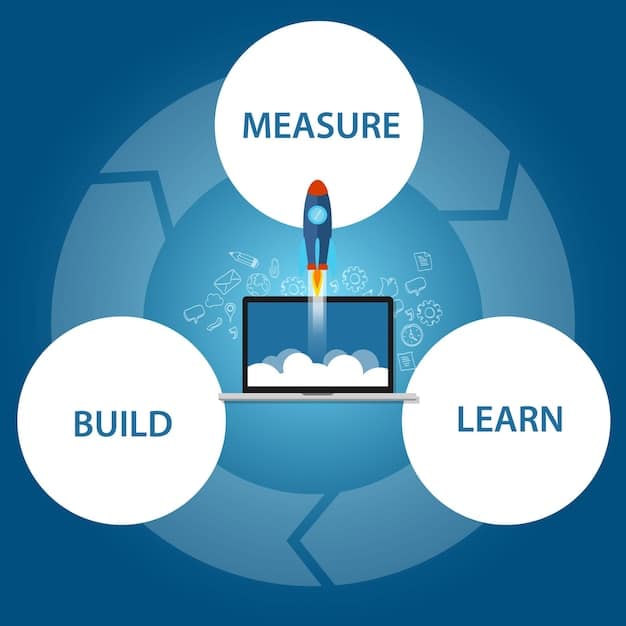The Lean Startup: Achieve Product-Market Fit in 90 Days

The Lean Startup methodology is a systematic approach to launching and scaling startups rapidly by focusing on customer feedback, iterative development, and validated learning to achieve product-market fit within a condensed 90-day timeframe.
The Lean Startup methodology: Achieve product-market fit in 90 days. Sounds ambitious? It’s a structured process for startups to minimize risk and maximize learning.
Understanding the Lean Startup Methodology
The Lean Startup isn’t just a buzzword; it’s a robust framework for building businesses effectively. It emphasizes building a minimum viable product (MVP), testing assumptions, and iterating based on customer feedback.
What is the core idea behind the Lean Startup?
At its core, the Lean Startup methodology challenges traditional, lengthy planning cycles. Instead, it promotes a build-measure-learn feedback loop.
Why is it important for startups?
Startups often operate with limited resources and a high degree of uncertainty. The Lean Startup helps them navigate this uncertainty by continuously validating their assumptions and avoiding costly mistakes.
- Minimize Waste: Focus on activities that create value for the customer.
- Validated Learning: Make decisions based on data and customer feedback.
- Rapid Iteration: Quickly adapt and improve the product based on learnings.

By embracing the Lean Startup principles, not only can startups save time and money, but they can also find product-market fit more efficiently.
Achieving Product-Market Fit
Product-market fit describes the degree to which a product satisfies market demand. It’s the holy grail of startups, indicating a sustainable and scalable business model.
Defining Product-Market Fit
Achieving product-market fit means having a product that resonates with a large enough customer base to sustain growth. It goes beyond initial traction and signifies a deeper connection.
Why is product-market fit vital for startups?
Without product-market fit, startups face a struggle to gain traction and are constantly battling churn. It’s the foundation upon which successful companies are built.
There are some key indicators or metrics to identify how fit the product is, they are:
- Customer Retention: High rates of repeat customers and low churn.
- Net Promoter Score (NPS): A strong indication of customer satisfaction and loyalty.
- Organic Growth: Word-of-mouth referrals and positive reviews driving new customer acquisition.
Product-market fit is not a static state; it’s a continuous process of refinement as the market evolves and also the needs of the customers in the actual market.
The 90-Day Sprint: A Practical Approach
Can you really achieve product-market fit in just 90 days? While results may vary, structuring your efforts around a 90-day sprint provides a focused and time-bound approach.
Planning Your 90-Day Sprint
Start with a clear definition of your target customer segment and their unmet needs. What problem are you solving, and for whom?
Setting Measurable Goals
Define specific, measurable, achievable, relevant, and time-bound (SMART) goals for your sprint. These goals should align with achieving product-market fit.

- Week 1-3: Focus on customer discovery, interviews, and initial hypothesis testing.
- Week 4-8: Development and launch of the first of the Minimum Valuable Product (MVP).
- Week 9-12: Testing and Analysis, Data-driven product iterations, and scale preparations.
90-days is the perfect time to implement, analyze, correct and grow in sprints.
Building Your Minimum Viable Product (MVP)
The MVP is a version of your product with just enough features to attract early-adopter customers and validate your product idea early on. It is more than just a prototype; it should be a complete product/service that customers can use without the need for extra explanation.
Identifying Core Features
The minimum set of features required to solve the problems and engage early adopters. Focus of these features is on maximizing the value to users and decreasing the development efforts.
Rapid Development and Deployment
Fast production to reach the point of validation, even using no-code tools to speed up the development process. Automate the maximum part of the business to have enough focus to achieve product-market fit in 90 days
You can validate your product/service with these techniques:
- A/B Testing: Comparing different versions of your product to see which performs best.
- Landing Pages: Creating simple websites to gauge interest in specific features.
- Customer Interviews: Gathering qualitative feedback directly from your target audience.
In today’s market, time is gold, an MVP will help to save time and money.
Iterating Based on Customer Feedback
Customer feedback is the compass that guides your product development journey. Embrace feedback, analyze it thoroughly, and use it to inform your next iterations. This does not mean the product should be fully oriented towards customer feedback, but have it in mind.
Establishing Feedback Loops
Creating a culture of continuous feedback by using surveys, user testing, and direct communication.
Prioritizing Feedback
Using a structured approach based on the overall strategic goals, frequency of occurrences, and the impact that these will have on the end users, ensuring that you focus on the key elements.
Key aspects that can be applied to the product/service are:
- Regularly Scheduled Meetings: Review customer feedback and plan iterations.
- Cross-Functional Collaboration: Involve different teams in the feedback analysis process.
- Transparent Communication: Keep customers informed about the changes you’re making based on their feedback.
Iteration is crucial to make your product/ service successful in the market, always focusing on the value that it gives to the end users.
Measuring Success and Adjusting Course
The Lean Startup methodology isn’t about blindly following a plan; it’s about learning and adapting. Continuously monitor your progress, measure your key metrics, and be prepared to adjust your strategy.
Key Performance Indicators (KPIs)
Choosing and tracking the right KPIs to measure progress and identify areas for improvement. Defining parameters such as user engagement, conversion rates, and customer satisfaction scores
Pivoting vs. Persevering
Understanding when to make a significant change in strategy vs. when to stay the course. Having a clear view of the data trends will help make such decisions.
Knowing when to change or stay aligned with the current strategy are based on the following:
- Regular Monitoring: Track KPIs and customer feedback on a weekly or bi-weekly basis.
- Data-Driven Decisions: Make adjustments based on quantitative data, not just gut feelings.
- Agile Mindset: Be prepared to pivot quickly if the data suggests a different direction.
The Startup methodology is not magic, measuring, adjusting and pivoting are key elements in the process.
| Key Point | Brief Description |
|---|---|
| 💡 Lean Startup | Methodology focused on validating ideas quickly. |
| 🎯 Product-Market Fit | Achieving a product that resonates with the market. |
| ⏱️ 90-Day Sprint | Time-bound execution to find market validation. |
| 🧪 MVP | Minimum Viable Product to test and learn quickly. |
FAQ
▼
The main goal is to minimize waste and maximize learning by quickly validating business ideas through customer feedback and iterative product development.
▼
The MVP allows startups to test their core assumptions with real users early on, helping to refine the product and align it with market needs.
▼
Key indicators include high customer retention rates, a strong Net Promoter Score (NPS), and organic growth driven by word-of-mouth referrals and great positive reviews.
▼
A 90-day sprint provides a focused and time-bound framework for startups to quickly validate their ideas, gather feedback, and iterate towards achieving product-market fit.
▼
Startups should establish feedback loops through surveys and direct communication with the customers, prioritize this feedback based on its frequency and strategic impact.
Conclusion
By embracing the Lean Startup principles, startups can navigate the uncertain path to product-market fit with greater agility and effectiveness. The 90-day sprint provides a structured framework to test assumptions, gather feedback, and iterate towards a product that truly resonates with customers and this is something that every startup should pursue from the very beginning.





